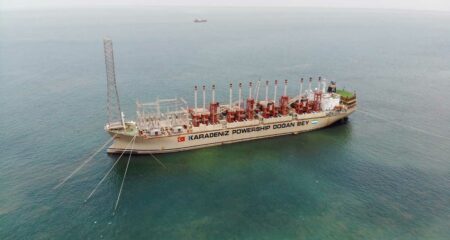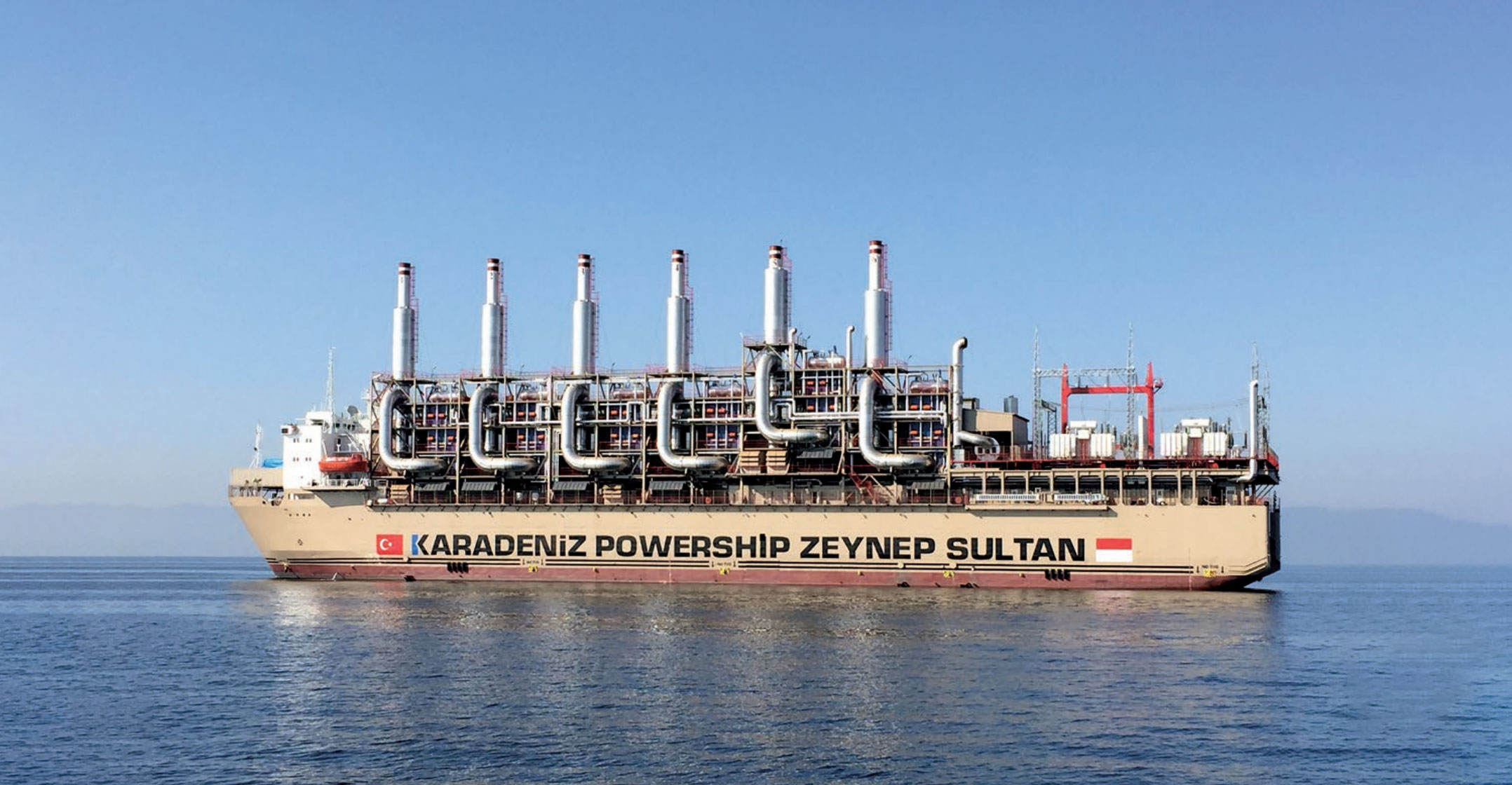 A flurry of social media activity by South African online influencers appears to be an attempt to minimise the impact of negative media coverage of the Karpowership consortium that was recently awarded a 20-year tender to provide emergency power to South Africa’s grid.
A flurry of social media activity by South African online influencers appears to be an attempt to minimise the impact of negative media coverage of the Karpowership consortium that was recently awarded a 20-year tender to provide emergency power to South Africa’s grid.
“Influencer marketing” — or the use of social media “influencers” to market products and services — has been growing as method of advertising. So, it shouldn’t be surprising, then, that these methods are being used to counter negative stories in politics and business.
This week saw a significant number of positive social media posts about Karpowership, the South African-Turkish consortium that recently won a tender to supply power to South Africa using port-moored, gas-fuelled generator ships for the next 20 years.
This seems more than coincidental given the increasing negative media scrutiny of the award of the tender, and that this social media activity peaked on the day before two negative articles were published by investigative journalism non-profit amaBhungane.
The fact that a large portion of those posts was from social media accounts with reasonably large followings and that many of those accounts have promoted a variety of consumer goods before also appears too good to be true.
#Ad
Best practice in influencer marketing entails an ethical and transparent component: Paid campaigns should be labelled as such. Social media influencers often include a small “#Ad” on their posts or indicate in other ways that their content is produced in partnership with a brand. Unfortunately, this is not the norm in South Africa, and most of the paid promotion is not transparently labelled as such. To identify it, it is often necessary to look for the aberrations from the normal posts in a country, or from the norm in the influencer’s online community. This can be done manually by reading the posts, or in a more structured algorithmic manner by examining a cohort of posts.
The hashtag #KarpowershipSA was first used in a tweet by Moneyweb on 13 April 2021, in which the finance publication linked to an article about the risks of the tender:
Government’s proposed deal with #KarpowershipSA to buy electricity generated on its three floating power stations over a period of 20 years will expose consumers to considerable risk …#Moneyweb #News #Mineralresources #karpowershiphttps://t.co/E2KW7sNfdJ
— Moneyweb News (@Moneyweb) April 13, 2021
The hashtag was then used by the official Twitter account of the powership consortium (@KarpowershipSA) over the period 20 April to the 7 May to publicise its offering, and head off criticism (to varying levels of success).
Who is @KarpowershipSA?
💡It is the holding company for 3 ring-fenced power generation project companies established for Coega, Richards Bay and Saldanha Bay.
💡 49% of it is owned by Powergroup SA (Pty) Ltd, a 100% South African, black owned and women empowered company.#energy pic.twitter.com/QCQzM6n1IB— KPS_SA (@KarpowershipSA) May 3, 2021
We strongly reject the allegation of impropriety on the part of @KarpowershipSA. All bidders followed the same transparent process and @KarpowershipSA was awarded bids because we provided the best combined package. The false allegations levied by a failed bidder are alarming.
— KPS_SA (@KarpowershipSA) April 30, 2021
Want to be part of the loadshedding solution? Follow us @KarpowershipSA 💡💡💡 #Loadshedding pic.twitter.com/oo8dCpBFcl
— KPS_SA (@KarpowershipSA) April 25, 2021
There were a few critical tweets over the same period, but then something changed. On the 13 May, there was a flurry of activity, starting with this tweet:
Thank you @Powerfm987 for bringing this Thought council to the listeners. So they can understand the transition of energy in a cheaper way.. I guess we will defeat loadshedding#karpowershipSa#AlternativeEnergy
— KE SHARP (@danielmarven) May 13, 2021
The @danielmarven account is a known twitter influencer and follow-train account; what is less clear is what broadcast he was referring to. It doesn’t seem that there was any broadcast on PowerFM regarding KarpowershipSA on the date of the tweet. In fact, the PowerFM broadcast focused on the powerships seems to be from 21 April – three weeks prior to the tweet. But what happened next is more unusual.
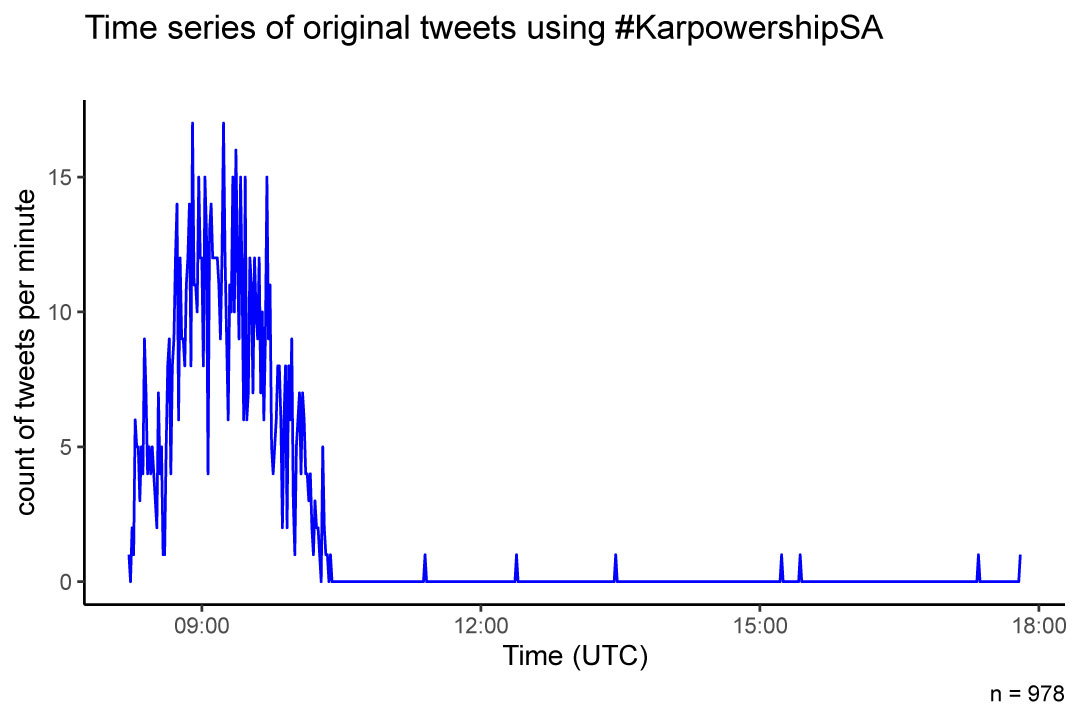 Over the next two hours and eight minutes, there was a torrent of pro-Karpowership tweets. Nine hundred and seventy original tweets in all, plus an additional 1 580 retweets. And then the original tweets just stopped.
Over the next two hours and eight minutes, there was a torrent of pro-Karpowership tweets. Nine hundred and seventy original tweets in all, plus an additional 1 580 retweets. And then the original tweets just stopped.
#karpowershipSa
People can’t be against a project that will help us as a country and increase job opportunities #AlternativeEnergy will definitely help solve this load shedding problem we’ve been facing.. pic.twitter.com/Op6w74XN62— Kuhle (@_kuhle_ntuli) May 13, 2021
#karpowershipSA#AlternativeEnergy
This project also works to comply with all environmental legislation meaning it is not a high risk project that could potentially cause a harmful effect to the environment— Kokisa (@king_kokisa) May 13, 2021
Honestly speaking we shouldn’t be experiencing load shedding and power outages. #karpowershipsa is the real solution to that and also it brings #AlternativeEnergy
— Uncle Gee 👑 (@GomolemoSA_) May 13, 2021
Honestly speaking we shouldn’t be experiencing load shedding and power outages. #karpowershipsa is the real solution to that and also it brings #AlternativeEnergy
— Uncle Gee 👑 (@GomolemoSA_) May 13, 2021
Some job opportunities will definitely be created and the economy of the country will rise 🙇🏾♂❤ #karpowershipSA#AlternativeEnergy
— Boss Zonke😀 (@TheoNkhata) May 13, 2021
In addition, there was a large volume of activity from a relatively small group of users, some tweeting more than 100 times in a relatively short period. Also, the topic seems odd for many of these accounts, which tend to tweet about music, make-up, food and beverage, and sport. It is slightly odd to see a cosmetics ambassador tweeting more than 200 times about a powership.
Here’s a sample of tweets by the top 10 users by volume:
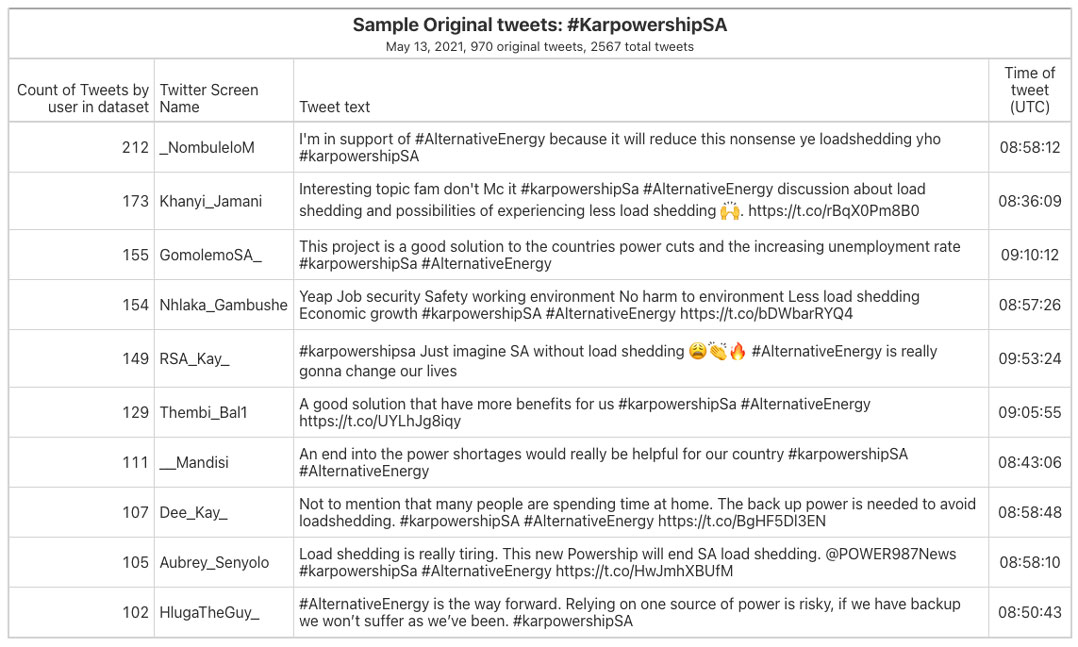 The fact that the activity was obviously suspect, even to casual observers, is even more apparent when looked at in aggregate. A typical South African local trending topic on Twitter has a distribution of users that peaks with a single peak of follower counts in the hundreds or low thousands of followers — that is, if we examine the number of followers of the account that makes each tweet, there is almost always a concentration of tweets from users with followers in the low thousands or fewer. And that’s a fairly standard distribution across an array of South African topics, largely because that is similar to the active South African Twitter community itself (there are simply more Twitter users in this range of followers).
The fact that the activity was obviously suspect, even to casual observers, is even more apparent when looked at in aggregate. A typical South African local trending topic on Twitter has a distribution of users that peaks with a single peak of follower counts in the hundreds or low thousands of followers — that is, if we examine the number of followers of the account that makes each tweet, there is almost always a concentration of tweets from users with followers in the low thousands or fewer. And that’s a fairly standard distribution across an array of South African topics, largely because that is similar to the active South African Twitter community itself (there are simply more Twitter users in this range of followers).
This is an example of a trending topic from South Africa for the term “polyandry”, a news item that has generated social media commentary:
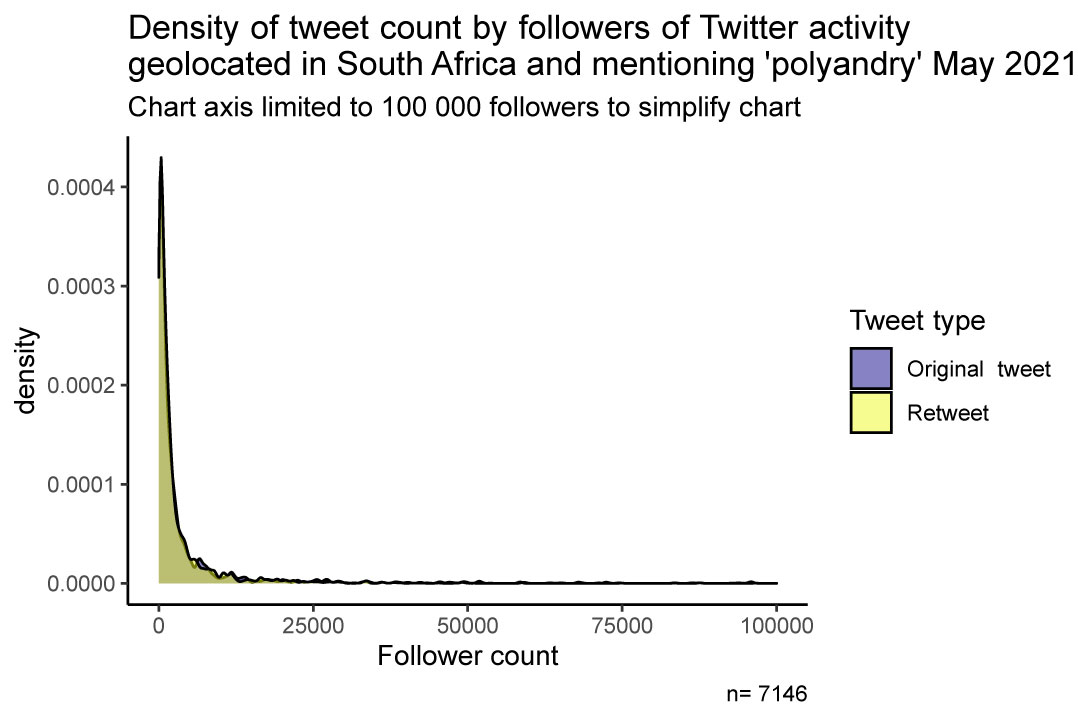 This is a chart of a random selection of tweets geolocated in South Africa from 13 May 2021:
This is a chart of a random selection of tweets geolocated in South Africa from 13 May 2021:
 The shape of these distribution is common for almost all social media topics that concern South Africa: a very steep peak in the low thousands of followers or fewer, decreasing rapidly to a long tail as the follower number increases.
The shape of these distribution is common for almost all social media topics that concern South Africa: a very steep peak in the low thousands of followers or fewer, decreasing rapidly to a long tail as the follower number increases.
The #KarpowershipSA hashtag activity on 13 May, however, shows a very different distribution. Rather than a single defined peak in the low thousands, it shows an obvious bimodal distribution with a large peak around 15 000 and another slightly smaller peak at around 150 000 (there is a another, much smaller, peak at just over 800 000, but this is less significant):
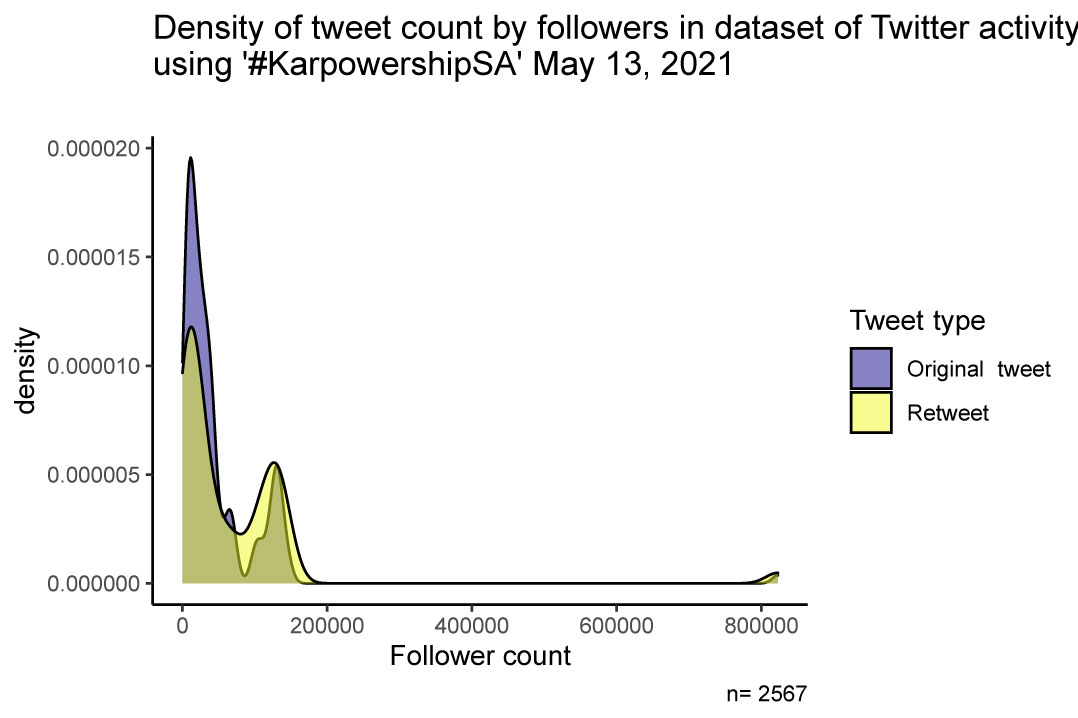 What this seems to indicate is that this topic has generated a much higher concentration of activity by accounts with large following. The outlier at 800 000 followers is the @danielmarven account, but most of the activity is by accounts with fewer than 200 000 followers. The difference between this kind of activity and that of a more generic topic is stark. But it isn’t unique. This kind of distribution is common for brand and commercial campaigns that use paid influencers to promote their product or service.
What this seems to indicate is that this topic has generated a much higher concentration of activity by accounts with large following. The outlier at 800 000 followers is the @danielmarven account, but most of the activity is by accounts with fewer than 200 000 followers. The difference between this kind of activity and that of a more generic topic is stark. But it isn’t unique. This kind of distribution is common for brand and commercial campaigns that use paid influencers to promote their product or service.
Here is an example of a campaign to promote a podcast series sponsored by the Bernini alcohol brand that is manufactured and marketed by Distell:
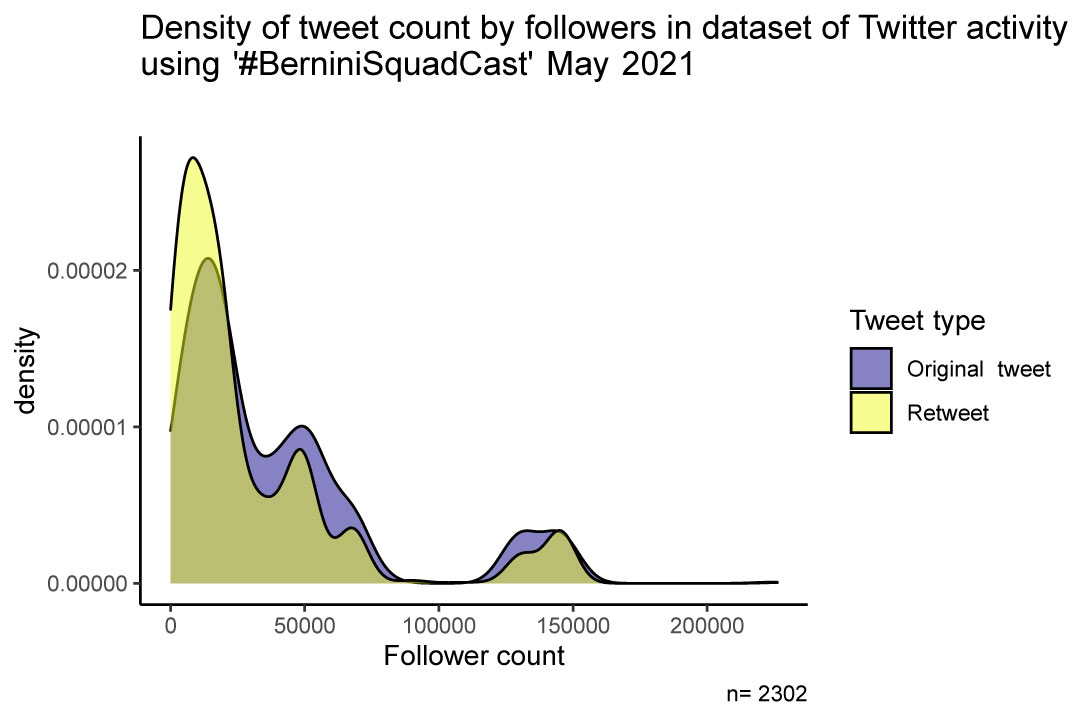 And here is a promotion for new music tracks from Africori, a boutique music label that promotes independent African artists:
And here is a promotion for new music tracks from Africori, a boutique music label that promotes independent African artists:
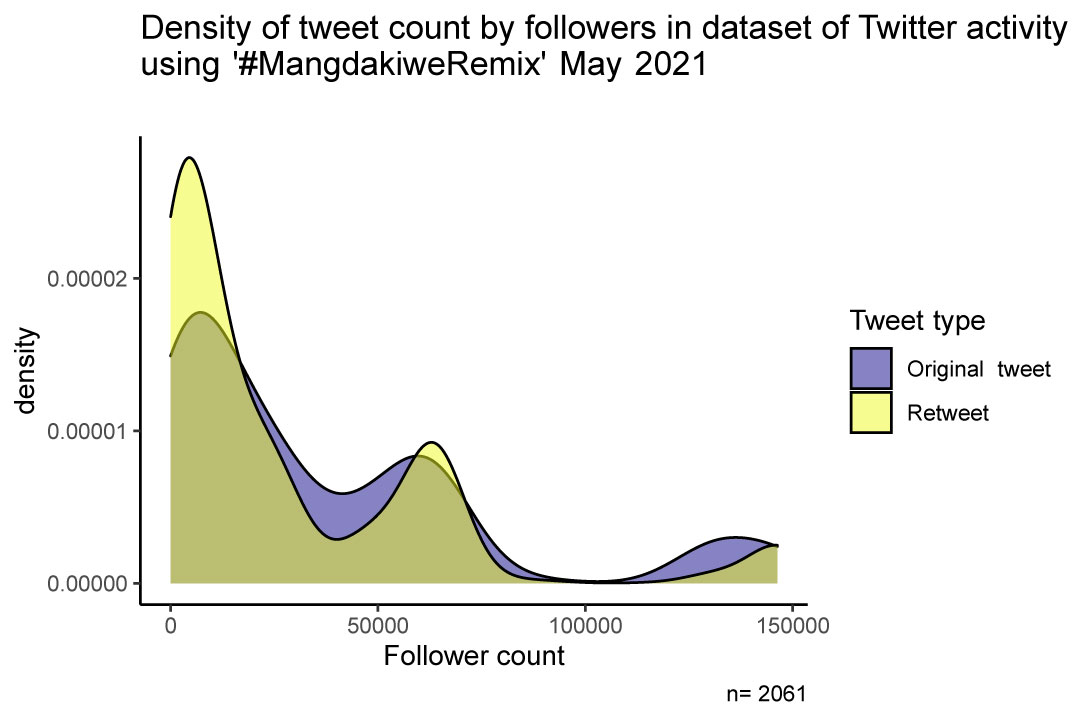 These kinds of promotions aren’t necessarily unethical; the use of influencers is an effective method to get the word out about new music, and Distell’s use of influencers to promote what looks like a social responsibility programme isn’t of itself a bad thing (the murkiness of an alcohol brand polishing its image notwithstanding). As mentioned previously, the ethical ideal for these kinds of promotions would entail the influencers being transparent about being paid, but this is not common.
These kinds of promotions aren’t necessarily unethical; the use of influencers is an effective method to get the word out about new music, and Distell’s use of influencers to promote what looks like a social responsibility programme isn’t of itself a bad thing (the murkiness of an alcohol brand polishing its image notwithstanding). As mentioned previously, the ethical ideal for these kinds of promotions would entail the influencers being transparent about being paid, but this is not common.
Another way to visualise the activity around a topic is with a network map. This is a method of visualising the connections between users. Communities of users can then be algorithmically defined, and their level of activity shown. In this map, the size of the nodes represents “out-degree” — the number of tweets authored by these users — the thickness of the edges or connecting lines shows how many connections there are between the various nodes, and the colour represents the algorithmic communities that have been calculated.
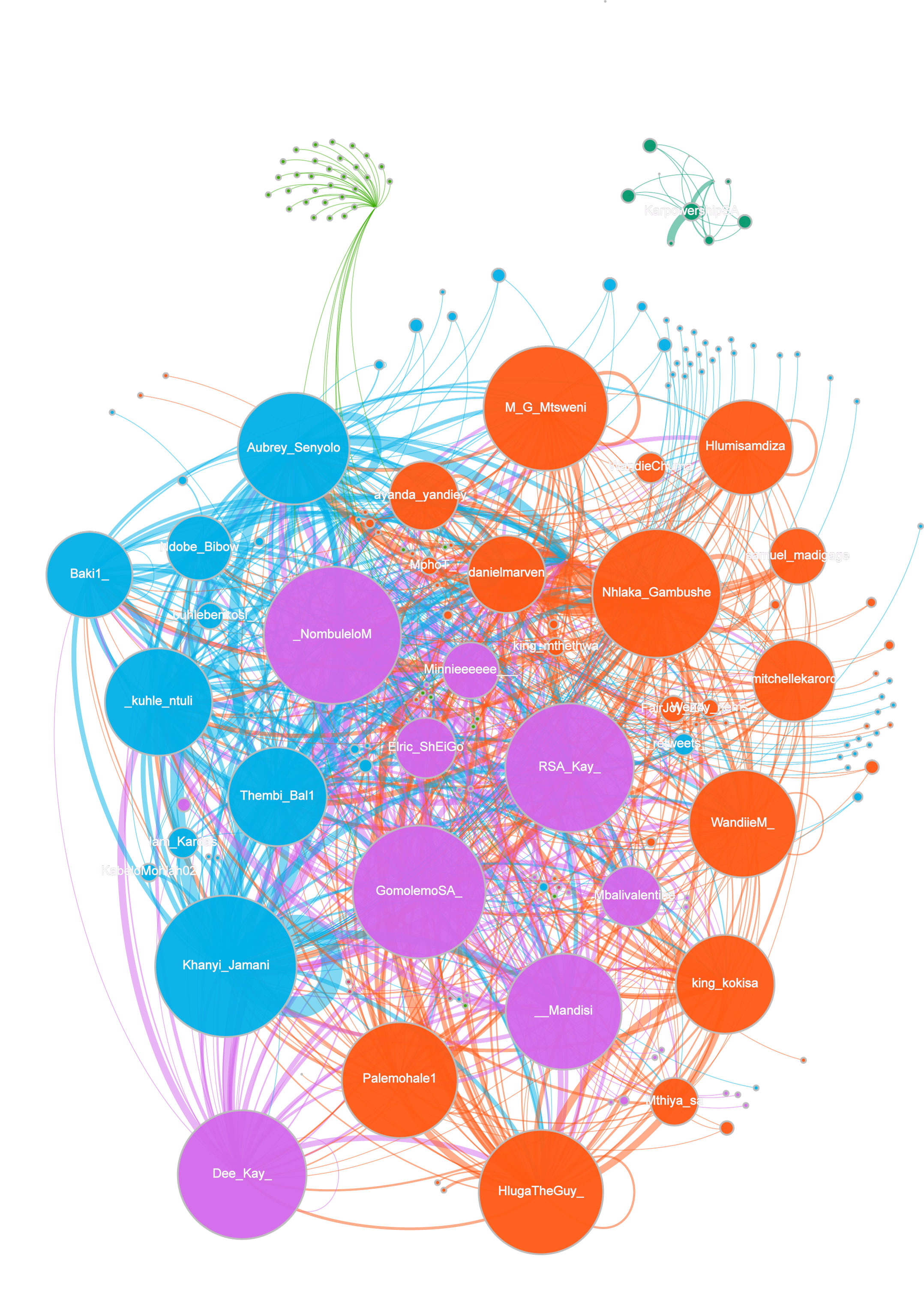
The light blue, orange and lilac nodes in the network are strongly interconnected, and this is the influencer campaign of tweets and retweets. What is interesting is that, despite the thousands of tweets and retweets, there is not a single connection between this large, interconnected cluster and the small green cluster in the top right. That small cluster contains the official @KarpowershipSA account. So, despite tweeting multiple times using the hashtag #KarpowershipSA, not a single user in the main cluster mentioned the company’s account.
While influencer campaigns aren’t necessarily unethical, in the case of the #KarpowershipSA campaign what is being promoted is not a product for sale or a social responsibility activity; it is a PR narrative. This is “dark” PR, a form of “astroturfing” (portraying a certain view as originating as grassroots comment, when in fact it is corporate messaging). This is disturbing.
It is highly likely that somebody involved with the KarpowershipSA consortium has invested a substantial sum to buy these tweets. It may not have been the company itself, or even its PR firm, but somebody close to the tender who has paid this money to try to sway public opinion the day before two negative articles were published. — (c) 2021 NewsCentral Media
- Note 1: Some of the tweets that were included in the analysis have since been deleted by their authors.
- Note 2: On 14 May, clicking on links to articles on amaBhungane’s website on Twitter caused a warning page to appear that stated that the links appeared to be unsafe. This was likely due to some organised malicious reporting of the domain to Twitter. It was resolved later in the day. When questioned, representatives of KarpowershipSA denied responsibility.




